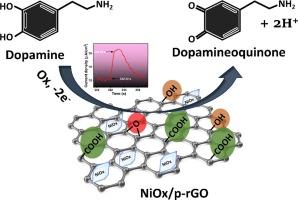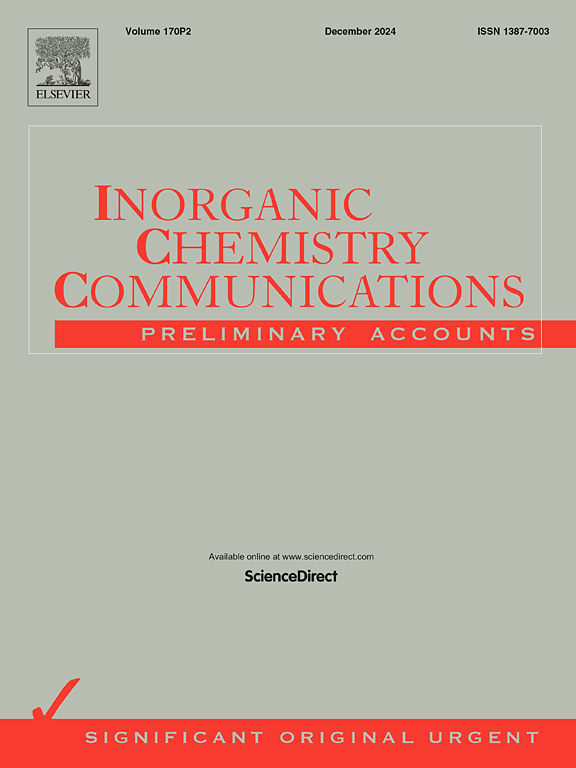在缺氧氧化镍/部分还原氧化石墨烯(NiOx/p-rGO)纳米复合材料平台上实现多巴胺的高灵敏度、选择性和快速体外电化学传感
IF 4.4
3区 化学
Q1 CHEMISTRY, INORGANIC & NUCLEAR
引用次数: 0
摘要
在这项工作中,我们努力应对在不影响灵敏度和选择性的前提下快速检测ppb或纳摩尔(nM)级神经递质多巴胺的挑战。在这里,我们选择了缺氧氧化镍(NiOx)与部分还原氧化石墨烯(即 p-rGO)进行复合。我们采用原位电化学技术,在掺氟氧化锡涂层玻璃基底上沉积 NiOx/p-rGO 纳米复合薄膜。沉积的薄膜在结构、相纯度、成分和形态方面都得到了全面的表征。通过循环伏安法、差分脉冲伏安法、计时阻抗法和电化学阻抗光谱法,确定了所制电极的详细电化学特性和传感属性。该传感平台对ppb 级多巴胺的体外传感灵敏度高达 24.76 µAµM-1cm-2,检出限极低,仅为 22.0 nM(即 4.17 ppb),响应时间极短,仅为 30 毫秒。从结构特性和传感性能的角度来看,所开发的传感平台具有足够的稳定性。此外,还对温度、pH 值和扫描速率的影响进行了详细研究。此外,还对成年男性尿液的真实样本进行了分析,结果表明回收率(98 - 100 %)和相对标准偏差(0.15 - 0.53)都很高,使该传感平台适用于现实生活中的应用。本文章由计算机程序翻译,如有差异,请以英文原文为准。

Highly sensitive, selective and rapid in-vitro electrochemical sensing of dopamine achieved on oxygen deficient nickel oxide/partially reduced graphene oxide (NiOx/p-rGO) nanocomposite platform
In this work, efforts have been given to address the challenge of rapid detection of the neurotransmitter dopamine in ppb or nanomolar (nM) order without compromising with sensitivity and selectivity. Here, oxygen deficient nickel oxide (NiOx) has been chosen to make composite with partially reduced graphene oxide i.e., p-rGO, which being another multifunctional material bears its own significance for this purpose. An in-situ electrochemical technique was adopted to deposit thin films of NiOx/p-rGO nanocomposite on fluorine doped tin oxide coated glass substrates. The deposited films were thoroughly characterized for structural, phase purity, compositional and morphological aspects. Detailed electrochemical properties and sensing attributes of the fabricated electrodes were established through cyclic voltammetry, differential pulse voltammetry, chronoamperometry and electrochemical impedance spectroscopy. The sensing platform delivered a markedly high value of sensitivity of 24.76 µAµM-1cm−2 towards in-vitro sensing of dopamine taken in ppb order; associated with a very low limit of detection of 22.0 nM, i.e., 4.17 ppb and a very fast response time of 30 ms. The developed sensing platform was found to be robust enough from the point of view of both structural properties and sensing performance. Detailed studies on the effect of temperature, pH and scan rate were also carried out. Analysis of real sample was also executed taking adult human male urine that yielded a promisingly good recovery factor (98 – 100 %) and fairly low relative standard deviation (0.15 – 0.53), making the sensing platform suitable for real life applications.
求助全文
通过发布文献求助,成功后即可免费获取论文全文。
去求助
来源期刊

Inorganic Chemistry Communications
化学-无机化学与核化学
CiteScore
5.50
自引率
7.90%
发文量
1013
审稿时长
53 days
期刊介绍:
Launched in January 1998, Inorganic Chemistry Communications is an international journal dedicated to the rapid publication of short communications in the major areas of inorganic, organometallic and supramolecular chemistry. Topics include synthetic and reaction chemistry, kinetics and mechanisms of reactions, bioinorganic chemistry, photochemistry and the use of metal and organometallic compounds in stoichiometric and catalytic synthesis or organic compounds.
 求助内容:
求助内容: 应助结果提醒方式:
应助结果提醒方式:


